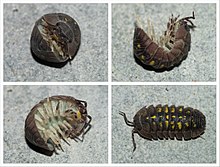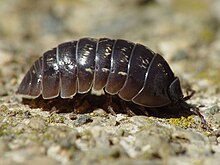Armadillidium
| Armadillidium | |
|---|---|

| |
| Armadillidium granulatum | |
| Scientific classification | |
| Kingdom: | |
| Phylum: | |
| Subphylum: | |
| Class: | |
| Order: | |
| Suborder: | |
| Family: | |
| Genus: | Armadillidium Brandt, 1833
|
| Diversity | |
| 178 species | |
Armadillidium (Template:Pron-en) is a genus of the small terrestrial crustacean known as the woodlouse. Armadillidium are also commonly known as pill woodlice, pill bugs or roly-poly, and are often confused with pill millipedes such as Glomeris marginata. They are characterised by their ability to roll into a ball when disturbed. They typically feed on moss, algae, bark and other decaying organic matter. They are usually found in moist areas such as decomposing leaf matter and soil. Armadillidium vulgare is the most abundant species in Europe and has been introduced worldwide.
The colouration especially of young A. klugii resembles the red hourglass marking of the Mediterranean black widow Latrodectus tredecimguttatus. This is probably a kind of mimicry, to ward off predators that mistake the harmless animal for a venomous spider.
Unlike other arthropods such as insects and spiders, pill bugs do not have a waxy cuticle that would reduce evaporation from their bodies. Pill bugs also use modified lungs, called pseudotrachea, for respiration, and the lungs must remain moist to function. Individual pill bugs typically live for two or three years, and females brood eggs once or twice each summer. Several hundred eggs are brooded at a time in the marsupium, a pocket on the ventral side of the female pill bug. The marsupium must also be kept filled with water until the young hatch and crawl away.
Species
There are 178 recognised species in the genus Armadillidium:[1]



- Armadillidium absoloni Strouhal, 1939
- Armadillidium aegaeum Strouhal, 1929
- Armadillidium aeginense Strouhal, 1939
- Armadillidium aelleni Caruso & Ferrara, 1982
- Armadillidium alassiense Verhoeff, 1910
- Armadillidium albanicum Verhoeff, 1901
- Armadillidium albigauni Arcangeli, 1935
- Armadillidium albomarginatum Verhoeff, 1901
- Armadillidium album Dollfus, 1887
- Armadillidium ameglioi Arcangeli, 1914
- Armadillidium amicorum Rodríguez & Vicente, 1993
- Armadillidium anconanum Verhoeff, 1928
- Armadillidium apenninigerum Verhoeff, 1936
- Armadillidium apenninorum Verhoeff, 1928
- Armadillidium apfelbecki Dollfus, 1895
- Armadillidium apuanum Taiti & Ferrara, 1995
- Armadillidium arcadicum Verhoeff, 1902
- Armadillidium arcangelii Strouhal, 1929
- Armadillidium argentarium Verhoeff, 1931
- Armadillidium argolicum Verhoeff, 1907
- Armadillidium artense Strouhal, 1956
- Armadillidium assimile Budde-Lund, 1885
- Armadillidium atticum Strouhal, 1929
- Armadillidium azerbaidzhanum Schmalfuss, 1990
- Armadillidium badium Budde-Lund, 1885
- Armadillidium baldense Verhoeff, 1902
- Armadillidium banaticum Verhoeff, 1907
- Armadillidium beieri Strouhal, 1937
- Armadillidium bicurvatum Verhoeff, 1901
- Armadillidium bosniense Strouhal, 1939
- Armadillidium brentanum Verhoeff, 1931
- Armadillidium bulgaricum Frankenberger, 1941
- Armadillidium calabricum Verhoeff, 1908
- Armadillidium canaliferum Verhoeff, 1908
- Armadillidium capreae Verhoeff, 1944
- Armadillidium carniolense Verhoeff, 1901
- Armadillidium carynthiacum Verhoeff, 1939
- Armadillidium cavannai Arcangeli, 1960
- Armadillidium cephalonicum Strouhal, 1929
- Armadillidium cetinjense Strouhal, 1927
- Armadillidium chazaliei Dollfus, 1896
- Armadillidium clausi Verhoeff, 1901
- Armadillidium clavigerum Verhoeff, 1928
- Armadillidium corcyraeum Verhoeff, 1901
- Armadillidium cruzi Garcia, 2003
- Armadillidium cythereium Strouhal, 1937
- Armadillidium dalmaticum Strouhal, 1939
- Armadillidium decorum Brandt, 1833
- Armadillidium delattini Verhoeff, 1943
- Armadillidium depressum Brandt, 1833
- Armadillidium djebalensis Vandel, 1958
- Armadillidium dollfusi Verhoeff, 1902
- Armadillidium elysii Verhoeff, 1936
- Armadillidium epiroticum Strouhal, 1956
- Armadillidium espanyoli Cruz, 1990
- Armadillidium esterelanum Dollfus, 1887
- Armadillidium etruriae Ferrara & Taiti, 1978
- Armadillidium euxinum Verhoeff, 1929
- Armadillidium fallax Brandt, 1833
- Armadillidium ficalbii Arcangeli, 1911
- Armadillidium flavoscutatum Strouhal, 1927
- Armadillidium fossuligerum Verhoeff, 1902
- Armadillidium frontemarginatum Strouhal, 1927
- Armadillidium frontetriangulum Verhoeff, 1901
- Armadillidium frontirostre Budde-Lund, 1885
- Armadillidium furcatum Budde-Lund, 1885
- Armadillidium galiciense Schmölzer, 1955
- Armadillidium germanicum Verhoeff, 1901
- Armadillidium gestroi Tua, 1900
- Armadillidium ghardalamensis Caruso & Hili, 1991
- Armadillidium granulatum Brandt, 1833
- Armadillidium hauseni Schmalfuss, 1985
- Armadillidium herzegowinense Verhoeff, 1907
- Armadillidium hessei Verhoeff, 1930
- Armadillidium hirtum Budde-Lund, 1885
- Armadillidium humectum Strouhal, 1937
- Armadillidium humile Strouhal, 1936
- Armadillidium inflatum Verhoeff, 1907
- Armadillidium insulanum Verhoeff, 1907
- Armadillidium irmengardae Strouhal, 1956
- Armadillidium janinense Verhoeff, 1902
- Armadillidium jaqueti Dollfus, 1897
- Armadillidium jonicum Strouhal, 1927
- Armadillidium justi Strouhal, 1937
- Armadillidium kalamatense Verhoeff, 1907
- Armadillidium kalamium Strouhal, 1956
- Armadillidium klaptoczi Verhoeff, 1908
- Armadillidium klugii Brandt, 1833
- Armadillidium kochi Dollfus, 1887
- Armadillidium kossuthi Arcangeli, 1929
- Armadillidium laconicum Strouhal, 1938
- Armadillidium lagrecai Vandel, 1969
- Armadillidium laminigerum Verhoeff, 1907
- Armadillidium lanzai Taiti & Ferrara, 1996
- Armadillidium littorale Taiti & Ferrara, 1996
- Armadillidium lobocurvum Verhoeff, 1902
- Armadillidium lymberakisi Schmalfuss, Paragamian & Sfenthourakis, 2004
- Armadillidium maccagnoae Arcangeli, 1960
- Armadillidium maculatum Risso, 1816
- Armadillidium mareoticum Budde-Lund, 1885
- Armadillidium marinense Verhoeff, 1902
- Armadillidium marinensium Verhoeff, 1928
- Armadillidium marmoratum Strouhal, 1929
- Armadillidium marmorivagum Verhoeff, 1934
- Armadillidium mateui Vandel, 1953
- Armadillidium messenicum Verhoeff, 1902
- Armadillidium mohamedanicum Verhoeff, 1929
- Armadillidium narentanum Verhoeff, 1907
- Armadillidium nasatum Budde-Lund, 1885
- Armadillidium niger Kortshagin, 1887
- Armadillidium obenbergeri Frankenberger, 1941
- Armadillidium odhneri Verhoeff, 1930
- Armadillidium oglasae Ferrara & Taiti, 1978
- Armadillidium omblae Verhoeff, 1900
- Armadillidium opacum (C. Koch, 1841)
- Armadillidium ormeanum Verhoeff, 1931
- Armadillidium paeninsulae Ferrara & Taiti, 1978
- Armadillidium pallasii Brandt, 1833
- Armadillidium pallidum Verhoeff, 1907
- Armadillidium panningi Strouhal, 1937
- Armadillidium pardoi Vandel, 1956
- Armadillidium parvum Strouhal, 1938
- Armadillidium pelagicum Arcangeli, 1957
- Armadillidium pelionense Strouhal, 1928
- Armadillidium peloponnesiacum Verhoeff, 1901
- Armadillidium peraccai Tua, 1900
- Armadillidium pictum Brandt, 1833
- Armadillidium pilosellum Dollfus, 1896
- Armadillidium ponalense Verhoeff, 1934
- Armadillidium portofinense Verhoeff, 1908
- Armadillidium pretusi Cruz, 1990
- Armadillidium pseudassimile Taiti & Ferrara, 1980
- Armadillidium pseudovulgare Verhoeff, 1902
- Armadillidium pulchellum (Zenker, 1798)
- Armadillidium quinquepustulatum Budde-Lund, 1885
- Armadillidium rhodopinum Verhoeff, 1936
- Armadillidium rojanum Verhoeff, 1936
- Armadillidium rosai Arcangeli, 1913
- Armadillidium ruffoi Arcangeli, 1940
- Armadillidium rupium Verhoeff, 1928
- Armadillidium sanctum Dollfus, 1892
- Armadillidium savonense Verhoeff, 1931
- Armadillidium saxivagum Verhoeff, 1901
- Armadillidium scaberrimum Stein, 1859
- Armadillidium scabrum Dollfus, 1892
- Armadillidium schmalfussi Caruso & Lombardo, 1982
- Armadillidium serrai Cruz & Dalens, 1990
- Armadillidium serratum Budde-Lund, 1885
- Armadillidium siculorum Verhoeff, 1908
- Armadillidium silvestrii Verhoeff, 1931
- Armadillidium simile Strouhal, 1937
- Armadillidium simoni Dollfus, 1887
- Armadillidium sordidum Dollfus, 1887
- Armadillidium stagnoense Verhoeff, 1902
- Armadillidium steindachneri Strouhal, 1927
- Armadillidium stolikanum Verhoeff, 1907
- Armadillidium storkani Frankenberger, 1941
- Armadillidium strinatii Vandel, 1961
- Armadillidium sulcatum Milne-Edwards, 1840
- Armadillidium tabacarui Gruia, Iavorschi & Sarbu, 1994
- Armadillidium teramense Verhoeff, 1933
- Armadillidium tigris Budde-Lund, 1885
- Armadillidium tirolense Verhoeff, 1901
- Armadillidium torchiai Taiti & Ferrara, 1996
- Armadillidium traiani Demianowicz, 1932
- Armadillidium tripolitzense Verhoeff, 1902
- Armadillidium tyrrhenum Taiti & Ferrara, 1980
- Armadillidium vallombrosae Verhoeff, 1907
- Armadillidium valonae Arcangeli, 1952
- Armadillidium verhoeffi Rogenhofer, 1915
- Armadillidium versicolor Stein, 1859
- Armadillidium versluysi Strouhal, 1937
- Armadillidium vulgare (Latreille, 1804)
- Armadillidium werneri Strouhal, 1927
- Armadillidium xerovunense Strouhal, 1956
- Armadillidium zangherii Arcangeli, 1923
- Armadillidium zenckeri Brandt, 1833
- Armadillidium zuellichi Strouhal, 1937
References
- ^ Helmut Schmalfuss (2003). "World catalog of terrestrial isopods (Isopoda: Oniscidea) — revised and updated version" (PDF). Stuttgarter Beiträge zur Naturkunde, Serie A. 654: 341 pp.
